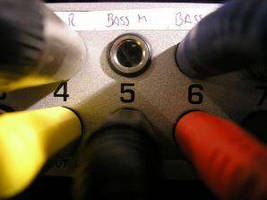7 Ways Signal Noise Can Impact Your Electrical Equipment

CAS DataLoggers Helps You Identify Power Issues and Increase Data Accuracy
CHESTERLAND OHÂ – Have you been having problems with your electrical equipment but haven't found the cause? For many users it turns out to be a very common, widespread problem called ground loop feedback--an electrical phenomenon which occurs when different electrical circuits are powering a system and its peripherals. When two or more connected electrical devices access more than one path to the ground, a loop forms which carries unintended current. Resistance then changes these currents into voltage fluctuations which cause signal noise which corrupts the devices' program signals. This wiring issue accounts for a large share of all power quality problems with A/V devices and other electronic equipment. To help you identify any of these issues you might have, the Applications Specialists at CAS DataLoggers have put together a short list of typical interference problems. Are you experiencing any of these issues?
1. You might encounter video problems on your displays, such as stripes and bars. It's easy to misdiagnose this symptom as a sign of old or defective equipment, but the cause may actually be more complicated and originate in your facility's grounding and wiring.
2. You may also notice audio problems such as buzzing or humming noises. As above, it's common for users to blame this on faulty equipment and replace a perfectly good system when in-depth troubleshooting might have resolved the problem.
3. PC interference and malfunctions including shutdowns and random network problems. These commonly crop up on computer networks. For example AC-powered computers are all connected to each other through the ground wire in common building wiring and/or data communications cables. These multi-path connections between computer circuits all form ground loops which can cause damage from inter-system ground noise.
4. Data drops and download gaps: If you're working on a data collection application, you'll often see interruptions in download progress and/or missing data after transfers are supposedly complete. This is especially irritating in remote monitoring applications where transfers need to be reliable so all parties are on the same page.
5. Power quality problems with electronic equipment such as voltage drops, equipment failure, resets, etc. These are notoriously difficult to diagnose, so we recommend using a power data logger to see if the issue actually stems from dirty power or another source.
6. Inaccurate readings and data from signal noise can negatively affect your whole process or research, and you might not notice the errors if you weren't aware there was a signal problem in the first place. This symptom is especially a threat to industrial processes given the sensitivity of newer electrical equipment.
7. AC Drive errors and burnouts: Newer AC drives - such as those used in AC motors - have a highly selective front end, and they especially react to signal noise on the line. If you're having this problem, you may need to make extensive grounding improvements to protect or improve the performance of just one of your machines.
Correcting Signal Noise
A ground loop problem can occur at several points in your system, and every instance of feedback has to be addressed on its own. You're mostly likely to get ground loops in the ground conductors of your electrical equipment wherever two or more circuits share the same conductor or current path. Check to see if your system includes equipment connected to different grounded outlets in the same room. Low-current wiring is especially likely to pick up interference.
You need a good grounding layout to prevent ground loops and reduce electronic noise as much as possible, using the ground to contain signal interference. However, nothing is perfectly grounded - whenever current flows, this resistance allows an electrical voltage to travel between those grounding points, increasing feedback.
While a ground always has some noise, you can significantly reduce ground loop problems. Proper grounding, wiring and an optimal facility layout will all contribute. Ground loops won't create impactful feedback if the wires in the loop aren't carrying current, although this might not be possible given your specific layout. If current is flowing in a wire, it will flow to other wires, and current can enter the loop from nearby fluctuating magnetic fields, so try to avoid these. Current can also flow directly into your electronic equipment through their cabling.
Eliminate ground loops by sending all signal grounds to a common point. If you have to use more than one grounding point, the signal must be isolated on one side and grounding from its neighbor(s). You can use shielded cables for low currents. Also try to remove or lessen any nearby radio frequency interference, and if you have devices putting a high demand on your power, install them closer to a power supply.
After taking these precautions, you should find that the above feedback symptoms are significantly reduced and your systems pick up much less noise. You'll see this improvement in the form of more accurate data, faster data transfers and fewer equipment and process issues.
For more information on how you can increase your accuracy, streamline your industrial process and setup automatic data downloads, or to find the ideal solution for your specific project needs, contact a CAS Data Logger Applications Specialist at (800) 956-4437 or visit the website at www.DataLoggerInc.com. Â
Contact Information:
CAS DataLoggers, Inc.
12628 Chillicothe Road
Chesterland, Ohio 44026
(440) 729-2570
(800) 956-4437
sales@dataloggerinc.com
www.dataloggerinc.com



